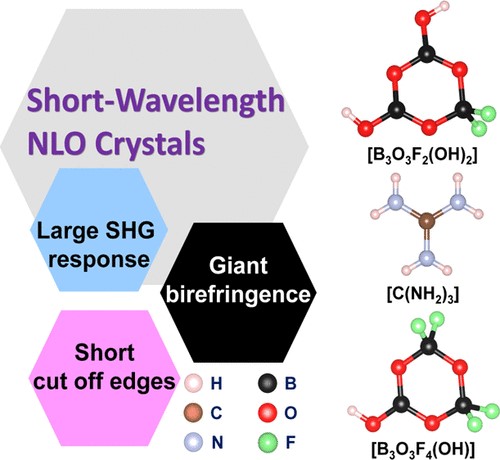Researchers from XTIPC discovered new short-wavelength UV nonlinear optical crystals
Editor: | Sep 01,2022
Crystalline metal-free borates that contain both oxoboron clusters and nonmetal components (such as ammonium, organic constituent, and so on) offer a new rich source for solid-state chemistry and crystalline materials. Metal-free borates have emerged as a new class of solid-state chemistry and related crystalline materials with high performance. However, the discovery of metal-free borate crystals that can meet the phase-matching behavior in the short-wavelength ultraviolet (UV) spectral region is extremely limited.
For a short-wavelength UV NLO crystal, the absorption edge, NLO coefficient, and shortest SHG PM wavelength reflected by birefringence are the three key parameters that should be satisfied. The collaborative assembly of π- and non-π-conjugated modules can control the key properties of NLO crystals. Given that it is possible to control the structure of metal-free borates, the key to the matter that requires to be solved is how to incorporate the π- with non-π-conjugated modules into one compound and also to retain the uniformly oriented planar arrangement at the same time? Herein, the π- conjugated planar [C(NH2)3] module was chosen as the cation as it has six coplanar hydrogen atoms that can emerge strong hydrogen bonds with N/O/F atoms, which is in favor of producing a coplanar configuration and thereby resulting in enhanced linear and nonlinear effects, which leads to the discovery of guanidinium-based NLO and birefringent crystals. For the B?O skeletons, the hydrogen-involved heteroanionic units are introduced in fluorooxoborates to construct new hydroxyfluorooxoborates, which has been proved to be an effective approach to increase the optical anisotropy and birefringence in our previous work. In addition, boron heterocyclic anions can make the cutoff edge blue shift to the spectral region near or below 200 nm and also help to extend the isolated units to the 3D structure. When the [C(NH2)3] cations are introduced into hydroxyfluorooxoborates to form metal-free compounds, the planar π-conjugated moieties are ordered within the restriction of hydrogenbonding interactions; the non-π-conjugated B?O/F units provide exocyclic F atoms that can further form hydrogen bonds in the vertical direction, which provides the feasibility of assembly of π- and non-π-conjugated units.
Recently, the research group led by Prof. Shilie Pan at Xinjiang Technical Institute of Physics & Chemistry (XTIPC), Chinese Academy of Science, synthesized two new metal-free hydroxyfluorooxoborates as novel NLO crystals by following the design strategy of assembling π- and non-π-conjugated modules. As a result, two new metal-free compounds with the chemical formula of [C(NH2)3][B3O3F2(OH)2] and [C(NH2)3]2[B3O3F4(OH)] were obtained and subjected to performance characterization, covering theoretical and experimental studies. The discovery of more metal-free hydroxyfluorooxoborates will expand the frontiers of the emergent fluorooxoborate system and then accelerate the discovery of novel short-wavelength UV NLO materials.
The paper was published on Chemistry of Materials with the title of “Guanidinium Fluorooxoborates as Efficient Metal-free Short-Wavelength Nonlinear Optical Crystals”. This work was financially supported by National Key R&D Program of China, Young Elite Scientist Sponsorship Program by CAST, National Natural Science Foundation of China, and the West Light Foundation of CAS.
Article: https://pubs.acs.org/doi/10.1021/acs.chemmater.1c03974

附件下载:
 (86) 991-3838931
(86) 991-3838931 lhskj@ms.xjb.ac.cn
lhskj@ms.xjb.ac.cn (86)991-3838957
(86)991-3838957 40-1 Beijing Road
Urumqi, XinjiangChina
40-1 Beijing Road
Urumqi, XinjiangChina